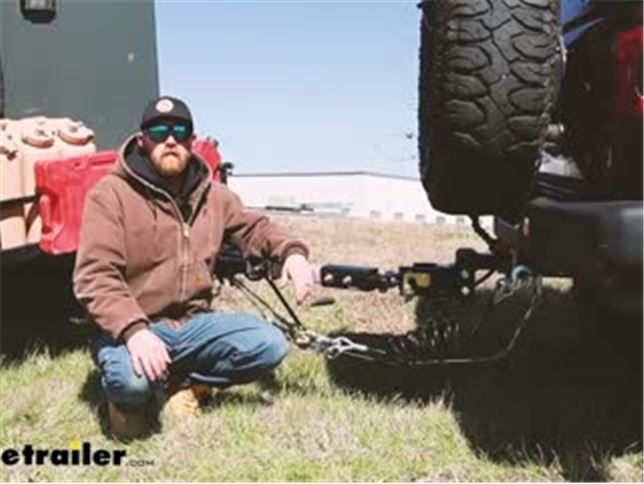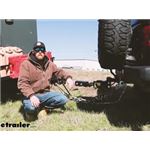Lock N Roll Articulating Coupler with 30" Extension - 2" Receivers - Trailer Side - 11K

Thank you! Your comment has been submitted successfully. You should be able to view your question/comment here within a few days.
Error submitting comment. Please try again momentarily.
- All Info
- Reviews (6)
- Q & A (0)
- Videos (2)
- Photos
Lock N Roll Accessories and Parts - 336TS526
- Trailer Hitch Ball Mount
- Hitch Mounted Coupler
- Lock N Roll
Ideal for the rigors of off-road towing, this fully articulating coupler pairs with a vehicle-side Lock N Roll hitch (sold separately) to form an extra-strong connection that is safe and secure, no matter the terrain. Extension offers high clearance.
Features:
- Trailer-side coupler links with Lock 'N' Roll vehicle-side hitch (sold separately) to hook up your trailer to your tow vehicle
- Shank inserts into your off-road trailer's hitch receiver
- Head unit provides attachment point for vehicle-side hitch
- More secure connection than with a traditional hitch ball
- Outer tabs on trailer-side coupler interlock with vehicle-side hitch to form strong connection
- No more worries about coupler popping off of ball
- Articulating design softens road shock and is great for off-roading
- Head unit pivots side to side
- Full articulation when paired with vehicle-end hitch - setup pivots up and down and rotates 360 degrees
- Tight, interlocked connection creates smoother, quieter ride than pintle hitch
- Close-fit connection reduces rattling noise and jerking motion
- 30" Extension allows extra distance between vehicle and trailer
- Perfect for carrying a canoe or kayak on top of the trailer
- Fast, easy hookup and disconnect
- Wide range of motion makes it easy to connect, even at an angle
- Steel alloy construction is strong and durable
- Black paint finish resists corrosion
- Meets SAE J684 towing safety regulations
- Hitch pin and clip or hitch lock sold separately
- Made in the USA
Specs:
- Application: off-road trailers with 2" x 2" receivers
- Maximum gross trailer weight: 11,000 lbs
- Maximum tongue weight: 1,100 lbs
- Length from hitch pin hole to center of coupler head unit: 33-1/2"
- Length of receiver tube (end to end): 30"
- Hitch pin hole diameter: 5/8"
- Limited lifetime warranty
This coupler combines with a Lock 'N' Roll vehicle-end hitch (sold separately) to create a safe, secure, fully articulating connection that's great for towing whether you're on the road or off-road. It's more secure than a traditional ball coupler, and it's more comfortable and quieter than a pintle setup. The Lock 'N' Roll connects quickly and easily, and can adapt to any towing conditions.
Strong, Safe Connection
When using a traditional ball coupler, it can be hard to tell if the coupler is fully latched around the ball. You can head out assuming the connection is secure, only to have the trailer pop off of the ball and disconnect while you're towing. With the Lock 'N' Roll, that won't happen.

This unique coupler is designed to interlock with a matching vehicle-side hitch to form a tight, secure connection. Unlike on a ball coupler, the latching components on the Lock 'N' Roll system are easy to see, so you can tell at a glance if the connection is secure.
Once secure, the Lock 'N' Roll setup offers a wide range of motion, which makes for a smooth ride. Because of the articulating action of the combined coupler and hitch, the Lock 'N' Roll connection can handle the harsh bumps and road shock that could otherwise stress and potentially damage a ball coupler.
The Lock 'N' Roll connection also makes your trailer less vulnerable to theft. Unlike a traditional ball coupler, which is compatible with any hitch ball of a matching size, the trailer-side Lock 'N' Roll coupler can only connect to a vehicle-side Lock 'N' Roll hitch. So your trailer cannot be towed away unless it's connected to a vehicle with a Lock 'N' Roll hitch installed.
With the Lock 'N' Roll, you can have peace of mind knowing your connection will not come apart or succumb to damage caused by road shock, nor will your trailer be vulnerable to theft.
Comfortable Off-Road Towing
The pintle hitch connection is the most common setup when towing off road because of the flexibility in the connection. But that flexible connection can also result in a lot of slop. This can cause uncomfortable jerking as well as rattle and noise. In addition, when using a pintle/lunette ring setup, it can be difficult to back up your vehicle and trailer without jackknifing. And it can be hard to disconnect at certain angles, which may be a necessity when overlanding.
The Lock 'N' Roll assembly, on the other hand, offers a close-fit, slop-free connection that's designed for off-roading. This close-fitting design provides a smoother ride than a pintle/lunette ring connection with less rattle. It also makes it easy to back your vehicle and trailer up without jackknifing.

With the trailer end and vehicle end combined, the Lock 'N' Roll setup also creates a fully articulating connection that's great for off-roading. The bearing that's built into the vehicle-end hitch allows for 360 degrees of rotation, which means that your trailer could actually roll all the way over and not take your vehicle with it. The connection also pivots side to side and up and down, making it easy to take rough trails without jarring your setup. This also allows for fast and easy disconnection, even at extreme angles.
How Lock 'N' Roll Works

Each Lock 'N' Roll setup requires 2 parts - a trailer end and a vehicle end. Together they create a strong, secure connection. To connect, just line up the trailer end and vehicle end together and place the outer metal tabs of the trailer-end coupler into the hooks on the vehicle-end hitch. Then fold the latching plates on the vehicle-end hitch down and secure them in place over the tabs using the pin and clip included with your vehicle-side hitch. With the latching plates secured, the Lock 'N' Roll assembly will stay firmly connected.

When the trailer-side coupler and vehicle-side hitch are secured together, they form an articulating assembly with 3 axes of directional motion. The uniquely designed bearing on the vehicle-side hitch allows the connection to rotate a full 360 degrees. The trailer-side coupler's hinge allows the connection to pivot to the left and to the right. And when the 2 sides are joined, the tabs will roll inside of the hooks so that the entire assembly can tilt up and down.
Towing with the Lock 'N' Roll is easy, and it gives you a connection that's both flexible and secure.
Get Maximum Security Locking Pins
Get extra security for your trailer. InfiniteRule makes hitch pin locks (IR59FR - sold separately) specifically for this Lock 'N' Roll articulating hitch. You'll get two stainless steel locks: one with a 1/2" diameter pin, and one with a 5/8" diameter pin. These will replace the standard pins and clips on the driver-side and trailer-side of your coupler.
TS526 Lock and Roll Pivoting Trailer Coupler with 2-1/2' Extension Tube - Trailer End - 2" Receivers - 11K


Videos are provided as a guide only. Refer to manufacturer installation instructions and specs for complete information.
Video Transcript for Lock N Roll 3-Position Channel Articulating Hitch Review
Hey everybody, Ryan here at etrailer. Today we're gonna be checking out the line of Lock N Roll articulating trailer couplers and hitches. Nowadays, Overlanding and bringing your small camper with your trail rig with you when you go off-roading is becoming more and more popular. And with traditional style ball mounts and trailer couplers being your connection point, sometimes that can lead to almost a dangerous situation. You know, when your angles are off like that, and your traditional style ones are only gonna allow for so much, and so you really, really have to be careful. And with a lock and roll system like this, it's really gonna help make everything more manageable and safe, and that's because we're gonna have our connection point here, that's gonna allow a ton of movement this way, as well as up and down.
And so it's gonna make things a lot more fun and safe. But with that said, you know, why don't we get right into it, and see how this thing works. We have a field here to play with today, nothing too crazy, but we'll go over some hills, some bumps, and play around a little bit, and really get a feel for this thing. So personally, I've been out doing some trail riding and, you know, going through the woods and stuff before. But I've never pulled a trailer behind me when I'm doing it.
And so I can imagine it'd be a little nerve-wracking. And so for a beginner like me, I feel like this product would help instill more confidence, because you might be on the timid side. I know I would, and I feel like this would be a lot more forgiving. And on the same note, I feel like it would be good for really experienced people, 'cause you guys already kind of know the limitations of your rig and your own personal limitations. And with this having a lot more forgiveness, in terms of allowing your trailer to, kind of, you know, articulate and everything do its own thing, you could probably get a little more aggressive.
And then that would open up your opportunities on where you could go camp, where you could go, you know, get off road, what trails you could hit, what rocks you go over, and things like that. So, you know, having that extra, you know, kind of boost confidence to me, you're out on the trail, and doing this type of stuff goes a long way. And not to mention too, you know, I mentioned safety with a standard type setup. You know, my thought is if your trailer or something gets hung up and ends up turning over, you know, tipping over, that could take your rig along with you too, and then flip over your Jeep or whatever you're out on the trail on, right But with this having, you know, it can rotate 360 degrees, I feel like that could save it. If something like that did happen, the trailer went, you know, went over on its side, because of the articulation in the hitch, it would keep, you know, your four by four upright.
And then you'd only have to deal with flipping the trailer back over, and not your whole setup. So pretty cool deal overall, and for its simplicity, you know, there's not a ton of moving parts and all this extra crazy stuff going on, I feel like it's a no-brainer if you're gonna be out doing this type of thing. So we've had our fun here, and I think it's safe to say, the setup works pretty good. You know, like I said, I'm not super experienced doing this type of thing, but it would definitely gimme that confidence and, going over some good bumps here, big old ditch, big over right here. What we're doing, getting off of the, this little area up here, and we're gonna head back inside, 'cause it is a cold, windy day. And we can talk a little bit more about how this works in there, I am cold. First we'll get back on the pavement, and on the way back to the garage, we actually have some bumps and a test course. my thought is, whenever you're going camping or whatever, or going to the trail, at some point you're gonna be on the concrete too, right So how's this thing gonna do on the concrete And I think it'll do really well. So that's what I'm doing now. Granted, our Jeep has such big tires and stuff, it's not a smooth ride regardless, so nothing really to tell there, but what I'm listening for is for, like, clunking or anything like that. I heard it clunk once when we we're up in the grass. And so far on the concrete, I'm not hearing it at all. And you know, I feel like that's how it's connected, and the fact that we're using that etrailer stabilizer definitely helps a lot. So that's something I'll recommend, and we'll talk about that in a minute. But right now, we're gonna go over some bumps. We have this bumps course here, and just see how it does, you know, you might get some good articulation in the trailer while we're doing this too. And so this would simulate, you know, a speed bump or something along those lines. And it feels good, I mean I don't, the whole rig doesn't feel, you know, like it's not working or, for lack of a better term, you know, like I said, that connection point back there, I've not noticed it clunking around or real sloppy or anything, the trailer's responsive. So even on the concrete, it's a good design, and I feel like it, it'll work regardless of the situation. Back in the garage, I got everything disconnected here, and just to really show off how much this thing really articulates. So, you know, this piece will go all the way complete from side to side, then the part on your vehicle will go 360. So it, you know, it's really unlimited how much this can articulate, in a sense, I guess you could say. So, you know, when you're at those extreme angles and everything, you're all good to go. And so here's what our neighbor upgraded from. So you just got your regular, you know, your regular ball mount there, and regular coupler. And let's see if I can manage to do this. If you lock that down, just to kind of compare, that's all you're gonna get with this. A little bit from side to side, a little bit up and down. Decent amount up and down, but, you know, that's minimal compared to what we're gonna get here. And this style really limit the possibility when you are on that rough terrain, and where you're gonna be able to take your camper. There are some other brands out there that will kind of accomplish the same thing as this. So here's one for example, this is Ark. It's kind of a, it's super heavy duty setup. The way this'll work is this'll get connected to your trailer side, right And I guess you could say that the mild benefit to this is your vehicle will still be able to use, kind of, the standard ball mount, you know, and this, that cup there will go over the ball. The thing is, with this, you know, you have full articulation and everything, it's smooth, it feels really well built, but, you know, I like the fact that we're able to adjust this one. You know, you can drop or rise the height there, according to your trailer. You know, in the future if you change things up, you're good. And I'm not super crazy about this mechanism, and I kind of feel like it might be a pain sometimes to get hooked up, 'cause you'll, there's so much movement there, you almost have to line it up perfect, and then you open this up, right, so you unlock it when it's in that position. This little piece in there stays wide open, and it's super rough in there too. But then when you go to lock it down, that goes into that position, and that actually engages the ball. So just a little bit, you know, of a different design. Do I think anything's wrong with it, no, I would use it, but on the same note, after, kinda, having some experience with this one, I'd probably be more partial to it, just because it seems a little more user-friendly, and a little more adjustable and things like that. So that's just my take on it. But with that said, you know, these parts are gonna be sold separately. So your trailer side, your vehicle side and and so on. And there are gonna be some differences for certain applications. So why don't we kind of just go through each side of it, and that way we can help you figure out what you're actually gonna need for your particular setup. To figure out what you're gonna need for your trailer side, it's pretty straightforward, it's really just gonna depend on the style of tongue that your trailer has, right So in our case we just have a square tongue, and this is a two inch diameter, and so we're using the two inch end here, which just slides over. So you're gonna have to measure that to figure out. There's some that are available, and for two and a half inch tongues, as well as three inch tongues. So kind of all the bases are covered there. And there's even some for a-frame type couplers as well. So that's really all there is to it in terms of figuring that out, and what part you're gonna need for the trailer side. Something I did notice with these, at least on our application is that this new part was quite a bit thicker than the original coupler that was on here. It makes sense, these are really heavy duty, really thick steel, and so what I had to do is get some longer bolts to feel comfortable, you know, having a good bite to hold this in place. So you might have to do that as well. Don't come with bolts, but can always pick 'em up at your hardware store. And with these two, if you don't wanna bolt it on, you can also weld 'em, so you got a couple of choices there in terms of actually getting this connected to your trailer. In terms of figuring out what you're gonna need for the vehicle side, it's pretty straightforward too. So what you're going to do is have your trailer and your vehicle on level ground, and, you know, back 'em up to each other about like this. And you wanna make sure that the trailer is gonna be level, or, you know, how you prefer to tow it. And so I have it level here, and then you just measure the distance from the coupler to the ground, and then your vehicle's hitch from the receiver tube opening down to the ground, and whatever that difference is, that's gonna determine the rise or drop that you're gonna need. So let's just say for example, if those measurements we're the same, get away with one that is straight. Let's say, in our case we have a Jeep. Let's say, if this was sitting up higher by two inches, right, then what your trailer is, a two inch drop would suffice. That way you can hook up and pull everything level. And in most cases, how people are gonna be using this type of setup, a lot of times, you probably will need a drop. And, you know, that's where the adjustable ones come into play, and things like that. So you can really fine tune your setup. And as far as the parts for the vehicle side, they're really nice, they're super thick steel, really heavy duty, you know, they're well made. And in our case today we're using an adjustable one, which is what I would recommend if you do need a drop or rise. They have some that are fixed. But my thought is, you know, let's say if you ever end up, you know, putting bigger tires on your vehicle, or lifting it up higher, getting a different trailer or something like that. Having that adjustability, it's just kind of a no brainer for me. You know, that way, or even if you get a different vehicle, you can take this stuff off and keep it, and then be able to tune it up to your particular trailer. With that said, these are not gonna come with a hitch pin to, you know, secure this into the trailer hitch. But InfiniteRule actually makes a set designed to work with this, this whole setup here and they give you a hitch pin and one that'll actually lock the vehicle's hitch to the trailer, and that's what we're gonna be using today. You know, it locks everything down and keeps it secure. So I got the other part of our setup on, and this is a part that'll connect here, it'll allow you to hook up to your trailer. And with the adjustable ones I'll give you a couple of bolts here, and you have those holes, and that's gonna let you set that position, right So pretty straightforward. One thing I did notice, it might just be our particular setup, but, you know, generally speaking, a lot of people find that you will have some play and rattle inside of there. And in our case, our neighbor already had the etrailer.com anti-rattle hitch stabilizer. Which it's loose right now, so I could show you that. But if we tighten the bolts down, (drill whirs) what that's gonna do is eliminate that slop and plane there. So you can see I'm moving our whole vehicle now, and just figured I'd mention that, you know, if that's something that bothers you, or if you have this device already, it is gonna be able to work with this setup. with something unique like this, I know I would wonder how it actually hooks up, and it's really not a whole lot different than just hooking up to a normal trailer. You know, you just have some different pieces here. So, you get it close, you know, just like you normally would. But instead of, you know, dropping down onto a ball, this is gonna drop down into those grooves there, get all the weights on it, and then these pieces will just sling over. And they do give you a pin and clip for this, right So pin would go through that, and the clip would would lock in onto that side to keep everything connected. So like I said, that comes with it. But being that we have upgraded, so to speak, to the InfiniteRule lock set, they're gonna give you a pin that's designed to work with this setup. That'll feed through, and then of course, we can lock it down here. So that's the setup we're going with today. So you might be wondering, you know, how hard is this gonna be to get all converted, you know what I mean And as far as the trailer side goes, it's really not bad. You're just going to have to simply replace the coupler here. Now everyone's setup is gonna be a little bit different, but, when it comes down to it, we'll have to get this switched over, and converted over to our new setup. In our case, we're just gonna have two bolts holding our existing coupler on, and so we'll just go ahead and get them pulled out, and then we should be able to simply just get the old coupler removed. With that old coupler off, I went ahead and kind of cleaned up the tongue, and we kind of have a special situation, I guess you could say. The tongue is aluminum, and with this being steel, I wanted to put something on to help protect again galvanic corrosion. You have two different types of metals touching. So I use some of this film that's meant for it. You will have to get this separately if this is your case. Most people it'll probably just, they'll have a steel tongue, and but this being steel, you don't need that layer. So just to play it safe, that's what I did. And then from there, really nothing to it, you know, the holes are gonna, we'll set that on, the holes will line up, and I coulda used the old bolts, they would've fell a little short. But since you're redoing, you know, redoing all this, I'm using some new nuts and bolts. And there's really not much to it, you know. Slide it through, we'll get these started. That way the new coupler here will stay in place. We'll go ahead and tighten this down. I like to actually, you know, make sure this is sitting flush. That way everything will pull the way it should. (drill whirring) (drill whirring) (drill whirring) (drill whirring) Once they're snug, then we can come back with a torque wrench and tighten the bolts down to the manufacturer's recommendations. From there it's simply just swapping out your existing ball mount on your vehicle with a new one, and that's really all there is to it. Other than that, at the end of the day, a really cool setup when you're putting this together and testing it out, one thing we did have to do, and I feel like this is worth mentioning, our electric cable fell a little bit short, and our safety cables did too, just because you know the little bit of extra length that that added. But that's just our particular situation, you know. Yours might be a little bit different, you might not have to worry about that. I just wanted to kind of, you know, something to think about. But aside from that, I mean this is a really cool setup. After, you know, taking it out and testing it and everything. You know, if I was gonna be doing this type of Overlanding, it's a must have, honestly. I mean just giving you that confidence, and that peace of mind knowing, you know, you have a lot more freedom in a sense. And I feel like it's a lot safer too. You know, this could potentially prevent an accident, or a costly repair to your camper, your vehicle, or whatever the case may be, you know So, if you're gonna be doing this type of a setup, definitely want to consider, and I think you will definitely not be disappointed. And that'll finish up our look at of the line of Lock N Roll articulating trailer couplers and hitches.
Customer Satisfaction Score:
86% were satisfied with this product
14% of customers were not satisfied
- Wrong item was ordered
Customer Reviews
Lock N Roll Articulating Coupler with 30" Extension - 2" Receivers - Trailer Side - 11K - 336TS526
Average Customer Rating: 4.8 out of 5 stars (6 Customer Reviews)
Ideal for the rigors of off-road towing, this fully articulating coupler pairs with a vehicle-side Lock N Roll hitch (sold separately) to form an extra-strong connection that is safe and secure, no matter the terrain. Extension offers high clearance.I haven’t had a chance to use it yet. I had to get someone to remove the current ball hitch and weld a receiver in its place for the trailer extension. The bad part of this is the part for the Jeep. The shaft is about 1/2” too long which keeps the pin holes from lining up. I have to get it cut a little to go into the receiver a little more. If you have a 2015 JK this may not work for you.
I bought this hitch as an insurance policy, so to speak, so that I feel comfortable when trailering my $24,000 Indian motorcycle across country. Ball hitches pop off to easily.
This was a big purchase along with the hitch. I can tell you it is 1000% worth it. So easy to hook up the trailer and unhook even at different angles.
See what our Experts say about this Lock N Roll Accessories and Parts
- Optional Lengths For Lock N Roll Articulating Trailer Coupler for 2" ReceiversYes, we carry the Lock N Roll Articulating Trailer Coupler for 2" Receivers in 3 different lengths. The # 336TS510 you found is 9-3/4" from the hitch pin center hole to the center of the coupler head. We also have it in a 18-1/2" Length # 336TS520 and a 33-1/2" Length # 336TS526.
view full answer...
Info for this part was:






At etrailer.com we provide the best information available about the products we sell. We take the quality of our information seriously so that you can get the right part the first time. Let us know if anything is missing or if you have any questions.



















































Kevin
7/22/2023
Works great, resolves all the issues I had previously